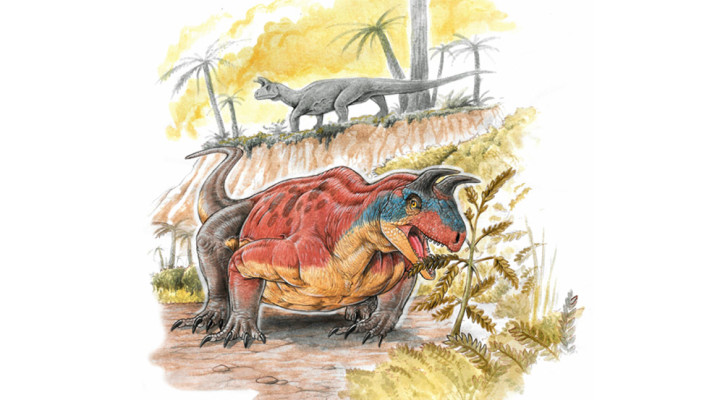BIOLOGICAL AND HEALTHS SCIENCES
Researchers find a horned reptile from the Middle Triassic of India
CONICET’s scientist participated in the study that deals with one herbivorous four-legged species with long-neck and small head.
A study published in Scientific Reports revealed the discovery of a new gender and species of stem-archosaur (a group that includes crocodiles, dinosaurs, birds and their ancestors) which lived 247−242 millions of years ago, 10 millions of years before the first dinosaurs appeared and about 5 to 10 millions of years after the mass extinction of the Permian-Triassic period.
“The name we chose to name the new gender is Shringasaurus, a combination of Greek and old Sanskrit words that means ‘reptile with horns’”, Martín Ezcurra comments. He is a CONICET’s researcher at the Museo Argentino de Ciencias Naturales “Bernardino Rivadavia” (MACN-CONICET) and one of the authors of the paper.
The Shringasaurus indicus is a four legged herbivorous species with long neck and small head. It is 3 or 4 meters long and 1,5 meters high up to the waist but its most remarkable feature is the long pair of horns on the skull just on its orbits.
“So far we thought that the only animals with horns that belonged to the Mesozoic Era (which stared 252 millions of years ago and finished 66 millions of years ago) were some of the dinosaurs of the Cretaceous period that actually appeared 100 millions of years after the species we found in India”, the researcher adds.
The mass Permian-Triassic extinction -the deadliest in history- that took place 252 millions of years ago killed up to 95 per cent of the marine and terrestrial species, what led to the diversification of several groups of plants and animals. In this process, the archosauromorphs –which had occupied a disregarded place– started to gradually dominate the terrestrial ecosystems.
The scientists know that the appearance of the horns in certain dinosaurs such as the ceratopsidae is an independent event in its emergence in the Shringasaurus. However, several lines of research indicate that in both cases those structures appeared through sexual selection, a special type of natural selection.
“We think that the Shringasaurus used its horns in combat with their peers of the same sex to get access to partners or define their territory”, the scientist describes.
The find and characterization of the Shringasaurus do not only reveal the existence of animals with horns before this anatomical structures appeared in dinosaurs but also provides new information on the terrestrial ecosystem functioning of the first stages of the Triassic period.
“As the Shringasaurus is a relatively large herbivorous species, it turned into the first archosauromorph that played the role of the primary consumers in its ecosystem, a role that during the first stages of Triassic was thought to be limited to a distant relative of the mammals” Ezcurra states.
The interpretation and characterization work was conducted in India, when Ezcurra was there thanks to a grant provided by the National Geographic to look for and study fossil remains of the oldest fauna of the Triassic in the region.
By Miguel Faigón.
About the study:
– Saradee Sengupta. Indian Statistical Institute, India.
– Martín D. Ezcurra. Associate researcher. MACN.
– Saswati Bandyopadhyay. Indian Statistical Institute, India.
